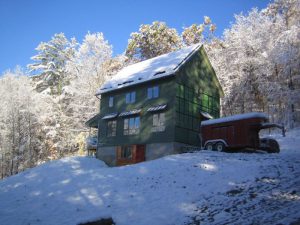Possibly not because although the Passive House standard is possibly the world’s leading design standard in energy efficient construction it’s not adapted to the climate in Spain.

In Spain we want inside outside spaces so we can enjoy the wonderful climate. The Passive House design principles include airtightness and a mechanical ventilation and heat exchanger which is just what you need when it’s very cold (e.g wintertime in Germany and northern Europe) but for most of the time in Spain we want to eat, play, and relax, outside on the terrace.
In my opinion these inside outside spaces, the pergolas, the terrace are the most important part of the home and being able to enjoy them in all seasons is a mark of good design. Being able to creat different moods for different moments with them is the mark of excellent design.
Click here for what we have to say about Inside Outside living.
In the meantime here is a short guide to what a Passive House is. We use these principles in our own designs and we adapt them to the climate in Spain.
Key Information
• A passive house is a German standard and is regulated by the passiv haus institute in Darmstadt Germany.
• The buildings are ultra efficient. It can be -10c outside and the building requires no heating.
• The standard is applied to residential property, offices, schools, and even refurbishments etc.
• There are about 50,000 certified passive house buildings worldwide with the vast majority being in German speaking countries and Scandinavia.
The main features of a passive house are: (and all energy efficient buildings incorporate these features to a greater or lesser extent although there is more to it as we shall see later)
Space Heating
• No conventional heating systems.
• Heat gains are body heat from the occupants and cooking.
• Some type of heating will still be required.
• This is normally distributed through the heat recovery ventilation system.
Superinsulation
• A wide range of materials can be used to provide the required high R-values (low U-values).
• Special attention is given to eliminating thermal bridges.
• A disadvantage is that the internal floor area of the building may be less compared to traditional construction because of the thicker walls.
Advanced window technology
• Windows have exceptionally high R-values (low U-values)
• E.g. triple paned argon or krypton filled e-coated glazing with air-seals and specially developed thermally broken window frames.
• Heat gains from south facing windows (in the northern hemisphere) can be greater than heat losses even in the winter.
Airtightness
• Building envelopes are required to be extremely airtight.
• Every construction joint and service penetrations are carefully sealed.
• Airtightness enables the mechanical ventilation system to recover the heat before discharging the air externally.
• (criticism is the homogenity of the temperature and air conditions through the building: like the starship Enterprise)
Ventilation
• Mechanical Ventilation and Heat Recovery systems are employed (MVHR)
• Maintains air quality
• Recover sufficient heat to dispense with a conventional central heating system
• Since the building is air tight the rate of air change can be optimized and carefully controlled.
• Natural ventilation is available when the exterior temperature is acceptable.
Cost of Build: On average passive houses are up to 14% more expensive than conventional buildings.
Passive Houses in Hot Climates
Principles are the same: to keep the building cool invert the heat recovery system. The building remains cool.
One difference is that human bodies heat the interior of the building. In fact they are the principle source of heat. So active (as opposed to passive) cooling may be necessary.
Occupants may prefer to have the windows open and enjoy inside /outside living in hot climates which compromises one of the main principles of passive house design.
Author: John Wolfendale
Bio: John is a founder of Eco Vida and is passionate about bringing modern design and construction practices to Spain. He believes a home which is warm in winter and cool in summer is largely a matter of design and selective use of materials. He is British and a Chartered Surveyor with 20
